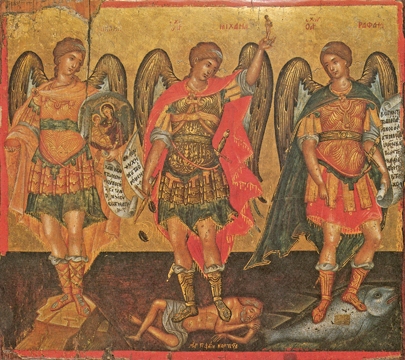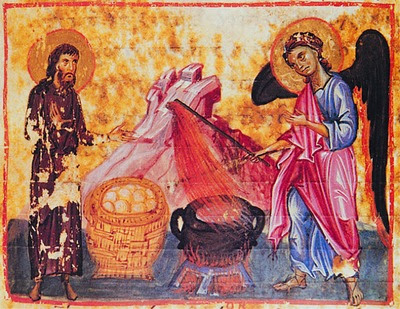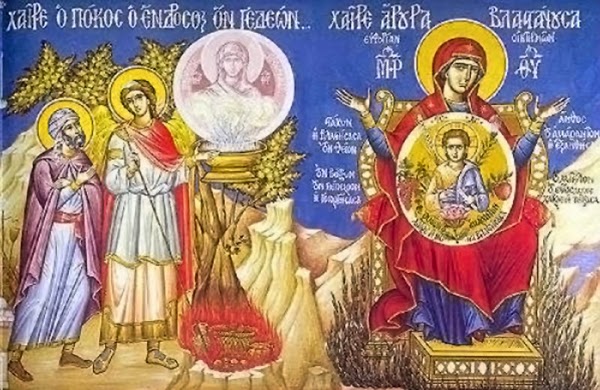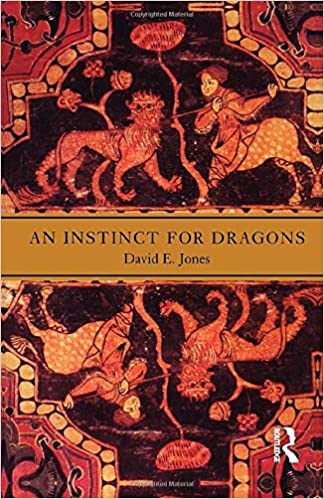
In the Old Testament, Tobit falls asleep in a garden and goes blind because the birds drop excrement on his eyes. Meanwhile, in faraway Media, a young woman named Sarah has prayed for death in despair. The demon Asmodeus (“the worst of demons”), abducts and kills every man Sarah marries on their wedding night before the marriage can be consummated. God sends the angel Raphael, disguised as a human, to heal Tobit and free Sarah from the demon.
Tobit sends his son Tobias to collect money that the elder has deposited in distant Media. Raphael presents himself as Tobit’s kinsman, Azariah, and offers to aid and protect Tobias. Under Raphael’s guidance, Tobias journeys to Media with his dog.
Along the way, while washing his feet in the river, a fish tries to swallow Tobias’ foot. By the angel’s order, he captures it and removes its heart, liver and gall bladder.
Upon arriving in Media, Raphael tells Tobias of the beautiful Sarah. The angel instructs the young man to burn the fish’s liver and heart to drive away the demon when he attacks on the wedding night. Tobias and Sarah marry, and the fumes of the burning organs drive the demon to Egypt, where Raphael follows and binds him. Since the wedding feast prevents him from leaving, Tobias sends Raphael to recover his father’s money.
After the feast, Tobias and Sarah return to Nineveh. There, Raphael tells the youth to use the fish’s gall to cure his father’s blindness. Raphael then reveals his identity and returns to heaven, and Tobit sings a hymn of praise.
We are accustomed to very short parables in the Gospels. Most are only a few sentences long; the longest–the Good Samaritan, the Prodigal Son–are a few paragraphs. The Book of Tobit is an extended parable that makes the point that God cares for his people and protects them in many ways. The fish is a good example.
Centuries before it was common to use a cross or crucifix, Christians often used a fish as a symbol of Christ and to indicate a Christian gathering place; the word “fish” in Greek is ichthys which is made of the initial letters of the words “Jesus Christ, Son of God, Savior.” The ichthys symbol is also a reference to the Holy Eucharist, which was associated with the miracle of the multiplication of the loaves and fishes. Christians interpreted the fish in this story of Tobit and Tobias as an allusion to Christ who saves the world from Death by his own death and resurrection.
Tobias takes the organs of the fish that are most full of blood and burns them as incense to drive away the demon. This illustrates the use of incense as an important tool in exorcisms because demons cannot stand the fragrance of incense. Blood is an allusion to both life and death; the bloody organs–liver and heart–are those associated with emotional and spiritual life, as well as physical life and death in the Ancient World. The power of Life–the power of God–made manifest in Christ’s death and resurrection drives the demon Asmodeus away.
The fish’s gall that heals Tobit’s eyes is also interpreted as an allusion to Christ, the light of the world, who heals the blind man in the Gospel of John (chapter 9). The blood of the fish (i.e. the blood of Christ) brings health (a variation of the Greek word “salvation”) to Tobit, Tobias, and Sarah–and to the world.



